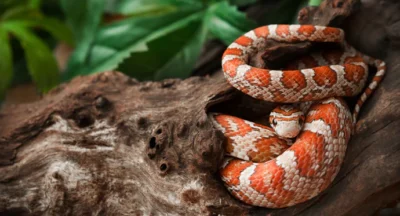Have you ever wondered, ‘Can corn snakes live together?’ It’s a common query among reptile lovers looking to add these stunning creatures to their collection. Corn snakes are known for their striking appearance and calm demeanor, sparking interest in whether they can coexist peacefully in groups.
Corn snakes are generally solitary creatures and do not require companionship for their well-being. In fact, keeping them individually housed is often recommended to prevent stress, competition for resources, and potential aggression.
While there are instances where corn snakes may cohabitate peacefully, it’s important to note that this arrangement requires careful planning and monitoring.
Can corn snakes live together?

Corn snakes are generally solitary creatures and prefer to live alone in their own territories. While it’s possible for multiple corn snakes to cohabitate in the same enclosure, it’s not recommended for several reasons:
- Territorial Behavior: Corn snakes, like many snakes, can exhibit territorial behavior. When placed together in a confined space, they may become stressed or aggressive as they compete for resources and space.
- Risk of Injury or Cannibalism: Corn snakes may mistake each other for prey, especially if they are hungry or if one snake is significantly smaller than the other. This can result in injury or even cannibalism.
- Spread of Disease: Keeping multiple snakes together increases the risk of spreading diseases and parasites between them, as they may come into direct contact with each other’s waste or bodily fluids.
- Breeding Risks: If you house male and female corn snakes together, they may breed. While breeding is natural, it requires careful planning and supervision to ensure the health and safety of both the snakes and any resulting offspring.
- Stress: Even if there is no direct aggression, simply being in close proximity to other snakes can cause stress, which can lead to health issues such as decreased appetite, susceptibility to illness, and even death.
If you do decide to house multiple corn snakes together, it’s crucial to provide a large enough enclosure with plenty of hiding spots, separate feeding areas, and careful monitoring to minimize the risks associated with cohabitation. However, for most keepers, it’s generally best to house corn snakes separately to ensure their health and well-being.
Factors to Consider Before Keeping Corn Snakes Together

Before deciding to keep corn snakes together, there are several important factors to consider:
- Enclosure Size: Ensure the enclosure is large enough to accommodate multiple snakes comfortably. Each snake should have sufficient space to establish its territory and retreat to separate hiding spots.
- Individual Personalities: Corn snakes, like humans, have unique personalities. Some may be more tolerant of others, while some may be territorial or aggressive. Consider the temperament of each snake before attempting cohabitation.
- Age and Size: Cohabitating snakes should be similar in size to minimize the risk of one snake overpowering or injuring the other(s). Avoid housing significantly larger or smaller snakes together.
- Sex: Cohabitating snakes of different sexes can lead to mating attempts, which may result in stress, injury, or unwanted pregnancies. It’s generally advisable to keep snakes of the same sex together or to house males and females separately.
- Health: Ensure all snakes are healthy and free from any contagious diseases or parasites before introducing them to each other. Quarantine new snakes before introducing them to an established group to prevent the spread of illness.
- Feeding Habits: Consider the feeding habits of each snake. Some snakes may be more aggressive feeders and may outcompete others during feeding time. Separate feeding areas or feeding on a regular schedule can help mitigate this issue.
- Behavioral Observations: Monitor the behavior of the snakes closely after introducing them to each other. Look for signs of stress, aggression, or dominance, and be prepared to separate the snakes if necessary.
- Hiding Spots: Provide ample hiding spots and visual barriers within the enclosure to allow each snake to retreat and establish its territory. This helps reduce stress and promotes a sense of security for each snake.
- Escape Prevention: Ensure the enclosure is secure and escape-proof to prevent any snakes from escaping or becoming injured while attempting to do so.
By carefully considering these factors and providing appropriate care and supervision, it is possible to keep corn snakes together successfully. However, always be prepared to separate them if conflicts arise or if any snake shows signs of distress or aggression.
Conclusion
While it’s possible for corn snakes to live together under specific conditions such as ample space, similar sizes, and careful monitoring, it’s generally recommended to house them individually to prevent stress, aggression, and health issues.
Each snake’s unique temperament, health status, and behavioral dynamics should be carefully considered before attempting cohabitation. Ultimately, prioritizing the well-being and safety of the snakes is paramount in determining whether can corn snakes live together harmoniously.

